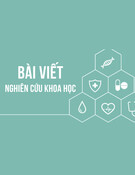
57
Tạp chí Y Dược học - Trường Đại học Y Dược Huế - Số 4, tập 10/2020
Địa chỉ liên hệ: Võ Tam, email: vtam@huemed-univ.edu.vn
Ngày nhận bài: 14/6/2020; Ngày đồng ý đăng: 28/8/2020
Nghiên cứu tương quan giữa khoáng xương và các yếu tố lâm sàng,
cận lâm sàng ở bệnh nhân lọc máu chu kỳ
Nguyễn Thanh Minh1, Võ Tam2
(1) Nghiên cứu sinh, Trường Đại học y Dược Huế, Đại Học Huế
(2) Bộ Môn Nội, Trường Đại học Y Dược, Đại học Huế
Tóm tắt
Mục tiêu: Khảo sát tương quan giữa nồng độ trong máu các khoáng xương: Phospho, canxi, PTH, vitamin
D, β2 microglobulin, aluminium máu với một số yếu tố lâm sàng, cận lâm sàng ở bệnh nhân bệnh thận mạn
lọc máu chu kỳ. Đối tượng và phương pháp nghiên cứu: Nghiên cứu mô tả cắt ngang, đối tượng nghiên
cứu gồm 163 bệnh nhân bệnh thận mạn đang lọc máu chu kỳ từ tháng 1/2017 đến tháng 12/2018 tại khoa
Thận nhân tạo, Bệnh viện Quận 2, thành phố Hồ chí Minh. Kết quả: Phospho máu tương quan nghịch với
độ tuổi r = - 0,342 ; tương quan thuận với albumin: r = 0,156, ure: r = 0,328, creatinin: r = 0,175, chỉ số canxi
x phospho: r = 0,809, PTH máu: 0,273. Canxi máu hiệu chỉnh tương quan nghịch với albumin: r = - 0,917,
Hb: r = - 0,369, ure: r = - 0,178, creatinin máu : r = - 0,188, chỉ số Canxi x Phospho: r = 0,492. PTH máu tương
quan thuận với thời gian lọc máu: r = 0,336, bêta 2 microglobulin máu : r = 0,247; tương quan nghịch với
Aluminium máu: r = - 0,161. Vitamin D máu tương quan nghịch với độ tuổi: r = - 0,166, β2 microglobulin
máu: r = - 0,231. Aluminium máu tương quan thuận với trị số huyết áp tâm trương: r = 0,207 và tâm thu: r =
0,209. β2 Microglobulin máu tương quan thuận với thời gian lọc máu: r = 0,233, ure: r = 0,168; tương quan
nghịch với Aluminium máu: r = - 0,224. Kết luận: Một số khoáng xương ở bệnh nhân lọc máu chu kỳ có tương
quan với tuổi, thời gian lọc máu, huyết áp, albumin, ure, creatinin máu và cũng có mối tương quan giữa các
khoáng xương với nhau. Vì vậy, cần tầm soát các rối loạn khoáng xương và các tương quan theo khuyến cáo
của KDOQI, KDIGO.
Từ khóa: bệnh thận mạn giai đoạn cuối lọc máu chu kỳ, tương quan,rối loạn khoáng xương
Abstract
The correlation between bone mineral disorders and some clinical and
subclinical factors in the patients with dialysis chronic kidney disease
Nguyen Thanh Minh1, Vo Tam2
(1) PhD Student of Hue University of Medicine and Pharmacy, Hue University
(1) Dept. of Internal Medicine, Hue University of Medicine and Pharmacy, Hue University
Objectives: To investigate the correlation between the concentration in blood of bone minerals: Phosphorus,
calcium, PTH, vitamin D, β2 microglobulin, aluminium with some clinical and subclinical factors in patients
with dialysis chronic kidney patients. Materials and Methods: Descriptive cross-sectional study, include 163
patients with dialysis chronic kidney disease, from January 2017 to December 2018 at the Department of
Haemodyalysis, District 2 Hospital, Ho Chi Minh City. Results: Serum phosphorus is negatively correlated with
age r = - 0.342; positively correlated with albumin: r = 0.156, urea: r = 0.328, creatinine: r = 0.175, calcium x
phosphorus index: r = 0.809,PTH: 0.273. Corrected serum calcium is negatively correlated with albumin: r = -
0.917, Hb: r = - 0.369, urea: r = - 0.178, creatinine: r = - 0.188, calcium x phosphorus index: r = 0.492. Plasma
PTH positively correlated with dialysis time: r = 0.336, β2 microglobulin: r = 0.247; negatively correlated with
Aluminum: r = - 0.161. Serum vitamin D negatively correlated with age: r = - 0.166, β2microglobulin: r = - 0.231.
Serum aluminium positively correlated with diastolic blood pressure: r = 0.207 and systolic: r = 0.209. Serum
β2 microglobulin positively correlated with dialysis time: r = 0.233, urea: r = 0.168; negatively correlated with
Aluminum: r = - 0.224. Conclusion: Some bone mineral in dialysis patients are correlated with age, dialysis time,
blood pressure, albumin, urea, creatinine. There is also a intercorrelation between bone minerals. Therefore, it
is necessary to screen for bone mineral disorders and correlations as recommended by KDOQI, KDIGO.
Keywords: End-stage chronic kidney disease, dialysis, correlation, bone mineral disorders
DOI: 10.34071/jmp.2020.4.7








































